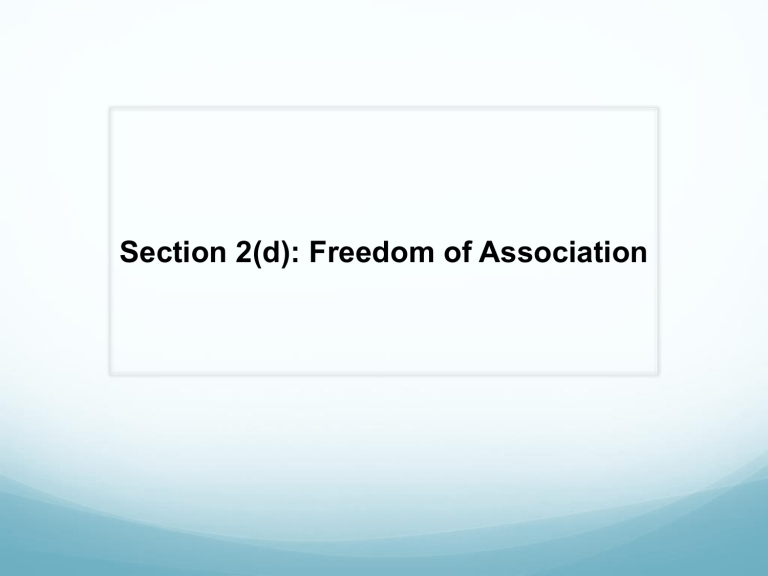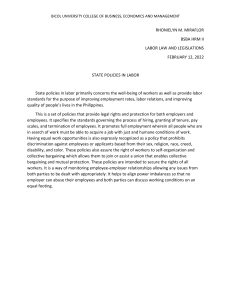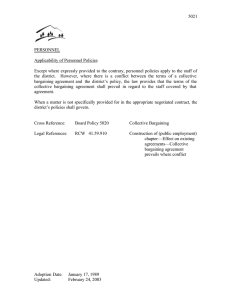
Section 2(d): Freedom of Association Freedom of Association is guaranteed by section 2(d) of the Charter, which protests the rights of individuals to come together to form a wide array of organizations and relationships, including those w political, religious and social purposes. Section 2(d) is intimately connected to the history of labour relations. the main questions that emerge from this section is whether s.2(d) include the right to join the trade union of one’s choice or refuse to join a trade union or pay dues. Also, to what extent does s.2(d) protects collective bargaining as well as the right to strike. Alberta Reference (1987): a majority of the SC held that the guarantee of FoA did not encompass the right to bargain collectively or the right to strike. The legislation at issue removed the right to strike from public sector workers, and in the absence of an agreement, prescribed mandatory arbitration to determine the contents of the collective agreement. J LeDain held that the rights to bargain collectively and strike are not fundamental rights or freedoms. Rather, they are the creatures of legislation that balances a number of competing interests. His decision was influenced by the notion that this area of labour law requires specific expertise and that the courts must defer to the legislature and specialized tribunals in this sphere. J McIntyre defined the scope of s.2(d) narrowly: ‘FoA..serves the interests of the individual, strengthens the general social order, and supports the healthy functioning of democratic government… [I]t must be recognized [however] that while it advances many group interests…it is nonetheless a freedom belonging to the individual and not to the group formed through its exercise…Freedom of Association cannot therefore vest independent rights in a group.’ McIntyre concluded that since collective bargaining is a group concern and activity, it is not guaranteed by s.2(d), which is a right asserted for the individual only. ‘The right to strike is not independently protected under the Charter, it can receive protection under FoA only if it is an activity which is permitted by law to an individual’. CJ Dickson delivered a famous dissent that would later on be relied on to reverse this decision. He took a broad approach to s.2(d), describing it as ‘the cornerstone of modern labour relations’. The guarantee of FoA included the rights of workers to bargain collectively and to strike. Although, he agreed that there is no individual equivalent to the right to strike, the dissenting judges held that this activity should be included in s.2(d) given its historic importance to the protection of the interests of working people: ‘Association has always been the means through which political, cultural and racial minorities, religious groups and workers have sought to attain their purposes and fulfill their aspirations; it has enabled those who would otherwise be vulnerable and ineffective to meet on more equal terms the power and strength of those with whom their interests interact and perhaps, conflict’. ‘Throughout history, workers have associated to overcome their vulnerability as individuals to the strength of their employers. The capacity to bargain collectively has long been recognized as one of the integral and primary functions of associations of working people…collective bargaining remains vital to the capacity of individual employees to participate in ensuring fair wages, health and safety protections and equitable and humane working conditions…’ Dunmore v Ontario (AG) [2001] 3 SCR 1016 J Bastarache, writing for the majority, concluded that ‘the freedom to collectively embody the interests of individual workers’ fell squarely within the protection of s.2(d) and that agricultural workers could not enjoy that freedom without protective labour legislation. He recognized the collective aspect of FoA, which was previously rejected in previous case law, referring to Dickson’s dissent in the Alberta Ref, he stated that individuals form associations ‘not simply because there is strength in numbers, but communities could embody objectives that individuals cannot’: ‘In my view, the appellants’ argument must prevail. What the legislature has done by reviving the LRA is not simply allow private circumstances to subsist; it has reinforced those circumstances by excluding agricultural workers from the only available channel for associational activity’. This in turn has a chilling effect on non-statutory union activity. Therefore, the court in Dunmore that the exclusion of agricultural workers from the LRA substantially interferes w their fundamental freedom to organize protected under s.2(d). S 3(b) of the LRA was declared as unconstitutional and the declarations was suspended for 18 months. Health Services and Support – Facilities Subsector Bargaining Assn v BC 2007 SCC 27 CJ McLachlin and J LeBel writing for the majority held that the protection of inherently collective activities recognized in Dunmore required a re-examination of the Labour Trilogy. They then concluded that these decisions excluding collective bargaining from the scope of s.2(d) can no longer stand. The court went through the rationale behind these decisions and concluded that the Labour Triology adopted a decontextualized approach in defining the scope of FoA in contrast to a purposive approach. This unfortunately overlooked the historical and contemporary importance of collective bargaining to the exercise of FoA in labour relations: ‘Workers in Canada began forming collectives to bargain over working conditions w their employers as early as the 18th C. However, the common law cast a shadow over the rights of workers to act collectively. When Parliament first began recognizing workers’ rights, trade unions had no express statutory right to negotiate collectively w employers. Employers could simply ignore them. However, workers used the powerful economic weapon of strikes to gradually force employers to recognize unions and to bargain collectively w them. By adopting the Wagner Act model…gov’ts across Canada recognized the fundamental need for workers to participate in the regulation of their work environment. This legislation confirmed what the labour movement had been fighting for over centuries and what it had access to in the laissez-faire era through the use of strikes – the right to collective bargaining w employers’. CB affirms the values of the Charter (including human dignity, equality and liberty): ‘Collective bargaining permits workers to achieve a form of workplace democracy and ensure the rule of law in the workplace’ since workers gain a voice in the governance of labour relations in the workplace. It puts workers and employers on an equal footing promoting equality under the law. The analysis to see whether s.2(d) was violated: First, collective bargaining is a limited right as it does not guarantee a certain substantive or economic outcome. So the first inquiry is into the importance of matter affected by collective bargaining. Second, the interference must be substantial enough to interfere not only w the attainment of the union members’ objectives but w the very process that enables them to pursue these objectives by engaging in meaningful negotiations w the employer. This inquiry is case and context specific – the question is always whether the process is voluntary, good faith collective bargaining has been adversely impacted. Both inquiries are necessary to establish a violation of S.2(d). Applying this to the facts at hand, the court found that ss. 4 and 5 of the Act could not be said to amount to substantial interference w the union’s ability to engage in collective bargaining so as to attract protection under s.2(d). however, the provisions dealing w contracting out, layoffs and bumping infringed the right to bargain collectively that is protected under s.2(d). This is because they deal w matters that are central to FoA and amount to substantial interference w associational activities. Ontario (AG) v Fraser CJ McLachlin and LeBel writing for the majority held that ‘bargaining activities protected by s.2(d) in the labour relations context include good faith bargaining on important workplace issues’ and that this ‘is not limited to a mere right to make representations to one’s employer, but requires the employer to engage in a process of consideration and discussion to have them considered by the employer’. Although the AEPA did not specifically require good-faith bargaining, the majority interpreted it to do so and held that the right to ‘a meaningful process’ can be infringed by a ban on employee associations or by setting up ‘a system that makes it impossible to have meaningful negotiations on workplace matters’ but s.2(d) ‘does not impose a particular process [and] does not require the parties to conclude an agreement or accept any particular terms and does not guarantee a legislated dispute resolution mechanism in the case of an impasse’. S.2(d) is a limited ‘to the right to a general process of collective bargaining, not a particular model of labour relations not a specific bargaining method’. J Rothstein agreed w the majority but for different reasons, emphasizing that s.2(d) does not impose duties to others, such as the duty to bargain in good faith on employers. J Abella dissented and would have upheld the decision of the CoA. In her view, Health Services created a ‘completely different jurisprudential universe’ and since the AEPA did not include any obligation for the employer to respond, it cannot be said to satisfy the good-faith bargaining obligation required in Health Services. Mounted Police Association of Ontario v Canada (AG) The Court held that s.2(d) must be interpreted in a purposive and generous manner that is consistent w the interpretation of other Charter rights. The majority adopted Dickson’s dissent in the 1987 Alberta Reference. Freedom of Association ‘empowers groups whose members’ individual voices may be all too easily drowned out’ and ‘helps them work to right imbalances in society’. It protects a meaningful process of collective bargaining. The held that CB must be seen as a necessary precondition of s.2(d)’s guarantee of FoA: ‘[A] legislative scheme that strips employees of adequate protections in their interactions w management so as to substantially interfere with their ability to meaningfully engage in collective negotiations’ will fail to satisfy the demands of s.2(d). Although the right guarantees a process rather than an outcome or specific model of collective bargaining, the majority held that employee choice and independence must be protected: ‘[A] meaningful process of CB is a process that gives employees meaningful input into the selection of their collective goals, and a degree of independence from management sufficient to allow members to control the activities of the association’. The scheme governing RCMP labour relations failed this test as it did not allow members to form their own association that was not dominated by management – it was essentially an internal human relations scheme imposed by management. The majority found that this infringement of s.2(d) could not be saved under s.1 as a reasonable limit. It was not rationally connected to achieving the objective of the legislation and did not satisfy the minimal impairment test. Saskatchewan Federation of Labour v Saskatchewan J Abella: the right to strike ‘is indispensible part’ of collective bargaining that is embedded in s.2(d). She traced the evolution of labour relations legislation from the criminalization of strike action in the 19th century to its legitimization w the passing of the Wagner Act model. The right to strike is also recognized in international law, namely the International Covenant on Economic, Social and Cultural Rights, and there is a meaningful consensus that if collective bargaining is to be meaningful, the right to strike needs to be recognized. Drawing once again to Dickson’s dissent in 1987, Abella wrote that the right to strike may be seen as furthering the Charter values of dignity, equality and autonomy of vulnerable workers allowing them through collective action to refuse work under imposed terms and conditions. The test for determining whether there is a violation of s.2(d) is to look at whether the legislative interference w the right to strike in a particular case amounts to a substantial interference w collective bargaining. Since the Saskatchewan legislation precluded essential employees from engaging in any work stoppage, that test was met. Turning to s.1, Abella recognized that maintaining essential services is a pressing and substantial objective and that banning strikes was rationally connected to that objective. However, the gov’t failed to show that the means chosen were minimally impairing that right. The legislation gave the employer unilateral authority to determine whether and how to maintain essential services and provided no meaningful review or dispute resolution mechanism to resolve bargaining impasses.


